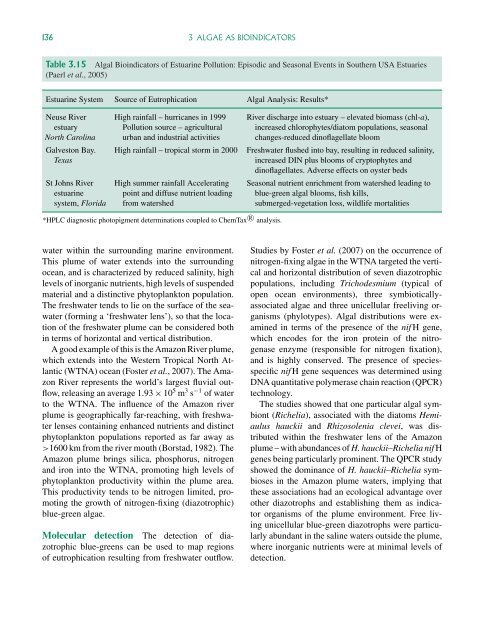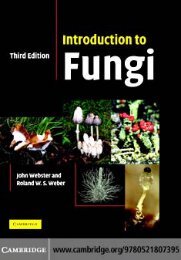Freshwater Algae: Identification and Use as Bioindicators
Freshwater Algae: Identification and Use as Bioindicators
Freshwater Algae: Identification and Use as Bioindicators
You also want an ePaper? Increase the reach of your titles
YUMPU automatically turns print PDFs into web optimized ePapers that Google loves.
136 3 ALGAE AS BIOINDICATORSTable 3.15 Algal <strong>Bioindicators</strong> of Estuarine Pollution: Episodic <strong>and</strong> Se<strong>as</strong>onal Events in Southern USA Estuaries(Paerl et al., 2005)Estuarine System Source of Eutrophication Algal Analysis: Results*Neuse RiverestuaryNorth CarolinaGalveston Bay.Tex<strong>as</strong>St Johns Riverestuarinesystem, FloridaHigh rainfall – hurricanes in 1999Pollution source – agriculturalurban <strong>and</strong> industrial activitiesHigh rainfall – tropical storm in 2000High summer rainfall Acceleratingpoint <strong>and</strong> diffuse nutrient loadingfrom watershedRiver discharge into estuary – elevated biom<strong>as</strong>s (chl-a),incre<strong>as</strong>ed chlorophytes/diatom populations, se<strong>as</strong>onalchanges-reduced dinoflagellate bloom<strong>Freshwater</strong> flushed into bay, resulting in reduced salinity,incre<strong>as</strong>ed DIN plus blooms of cryptophytes <strong>and</strong>dinoflagellates. Adverse effects on oyster bedsSe<strong>as</strong>onal nutrient enrichment from watershed leading toblue-green algal blooms, fish kills,submerged-vegetation loss, wildlife mortalities*HPLC diagnostic photopigment determinations coupled to ChemTax R○ analysis.water within the surrounding marine environment.This plume of water extends into the surroundingocean, <strong>and</strong> is characterized by reduced salinity, highlevels of inorganic nutrients, high levels of suspendedmaterial <strong>and</strong> a distinctive phytoplankton population.The freshwater tends to lie on the surface of the seawater(forming a ‘freshwater lens’), so that the locationof the freshwater plume can be considered bothin terms of horizontal <strong>and</strong> vertical distribution.A good example of this is the Amazon River plume,which extends into the Western Tropical North Atlantic(WTNA) ocean (Foster et al., 2007). The AmazonRiver represents the world’s largest fluvial outflow,rele<strong>as</strong>ing an average 1.93 × 10 5 m 3 s −1 of waterto the WTNA. The influence of the Amazon riverplume is geographically far-reaching, with freshwaterlenses containing enhanced nutrients <strong>and</strong> distinctphytoplankton populations reported <strong>as</strong> far away <strong>as</strong>>1600 km from the river mouth (Borstad, 1982). TheAmazon plume brings silica, phosphorus, nitrogen<strong>and</strong> iron into the WTNA, promoting high levels ofphytoplankton productivity within the plume area.This productivity tends to be nitrogen limited, promotingthe growth of nitrogen-fixing (diazotrophic)blue-green algae.Molecular detection The detection of diazotrophicblue-greens can be used to map regionsof eutrophication resulting from freshwater outflow.Studies by Foster et al. (2007) on the occurrence ofnitrogen-fixing algae in the WTNA targeted the vertical<strong>and</strong> horizontal distribution of seven diazotrophicpopulations, including Trichodesmium (typical ofopen ocean environments), three symbiotically<strong>as</strong>sociatedalgae <strong>and</strong> three unicellular freeliving organisms(phylotypes). Algal distributions were examinedin terms of the presence of the nif H gene,which encodes for the iron protein of the nitrogen<strong>as</strong>eenzyme (responsible for nitrogen fixation),<strong>and</strong> is highly conserved. The presence of speciesspecificnif H gene sequences w<strong>as</strong> determined usingDNA quantitative polymer<strong>as</strong>e chain reaction (QPCR)technology.The studies showed that one particular algal symbiont(Richelia), <strong>as</strong>sociated with the diatoms Hemiaulushauckii <strong>and</strong> Rhizosolenia clevei, w<strong>as</strong> distributedwithin the freshwater lens of the Amazonplume – with abundances of H. hauckii–Richelia nif Hgenes being particularly prominent. The QPCR studyshowed the dominance of H. hauckii–Richelia symbiosesin the Amazon plume waters, implying thatthese <strong>as</strong>sociations had an ecological advantage overother diazotrophs <strong>and</strong> establishing them <strong>as</strong> indicatororganisms of the plume environment. Free livingunicellular blue-green diazotrophs were particularlyabundant in the saline waters outside the plume,where inorganic nutrients were at minimal levels ofdetection.
















